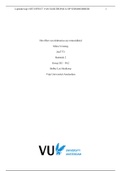Summary Remote Sensing
Chapter 1. What is Sensing?
Remote sensing (earth observation) refers to “obtaining information about objects or areas at the Earth’s surface
by using electromagnetic radiation (light) without being in direct contact with the object or area.”
The human eye is limited to 400 – 700 nm
➢ The visible spectrum (VIS).
400 – 700 nm
Measure solar radiation reflected by the objects at the Earth’s surface.
There are tools to make parts outside this range visible, such as the:
- Near-infrared (NIR): .
0.75 – 1.3 µm
Measure solar radiation reflected by the objects at the Earth’s surface.
- Middle-infrared (MIR):
1.3 – 2.6 µm
Measure solar radiation reflected by the objects at the Earth’s surface.
- Thermal-infrared (TIR):
Measure emitted radiation by the objects at the Earth’s surface (although this radiation originates from
the sun).
- Microwaves:
Measure both reflection and emission at very low energy rates.
➢ Therefore, radiation mostly is transmitted to the Earth’s surface by an antenna on board of the
remote sensing system and, subsequently, we measure the amount of radiation reflected
(backscattered) towards thát antenna.
➢ This is called an Active remote sensing system.
Not susceptible for atmosphere scattering
➢ Penetration through cloud cover, haze and (all but the heaviest) rainfall is possible.
Data collection:
Can be done by:
- Satellites
- Airplanes
- UAV’s (Drones)
- In situ
,Measurement phase components:
A: The source of EM radiation
B: The path through the atmosphere
C: The interaction with the object
D: The recording of the radiation by a sensor
Second phase components:
E: Transmission, reception and (pre)processing of the recorded radiation
F: Interpretation and analysis of the remote sensing data (mostly using a computer)
G: Creation of the final product, which is mostly stored as a GIS layer.
The atmosphere
Before solar radiation reaches the Earth’s surface, the atmosphere will influence it. In addition, it also influences
the reflected solar radiation or emitted radiation by an object on the Earth’s surface before it is detected.
The most important processes influencing the radiation are:
- Scattering: the formation of diffuse radiation
- Absorption: caused by (for example) the presence of water vapour.
Object – radiation interaction
When EM radiation hits the Earth’s surface, it can be reflected, absorbed or transmitted. The mutual magnitude
of these 3 processes is determined by the characteristics of the object on the surface.
In remote sensing it is possible to measure the amount of reflected solar radiation as a function of wavelength,
which is called the spectral reflectance.
Spectral reflectance curves of water, soil and vegetation:
, ➢ The moisture content of the soil causes wet soil to have a lower reflectance than a dry soil.
➢ Water also causes the gradually decreasing reflectance in the MIR region.
➢ For vegetation, the reflectance in the visible part is low due to absorption of radiation by the
chlorophyll in the green plant parts.
➢ The reflection in the NIR is high because of the amount of transitions between cell walls and air
vacuoles in the leaf tissue.
Active vs passive microwave sensors
Passive: detects the naturally emitted microwave energy
➢ Emitted energy is related to the temperature and moisture properties of the emitting object.
➢ Since energy levels are very small, a passive sensor has a low spatial resolution (typically 50km).
Active: provide their own source of illumination.
➢ Called ‘radars’
➢ Measure the amount of energy scattered back towards the radar antenna.
➢ With radar, we can get information on object properties such as geometry (terrain topography),
roughness (height variation in relation to the applied wavelength) and moisture (determining the
electrical properties of a soil or vegetation).
Active vs passive sensors
Passive: do not have their own source of radiation. Only sensitive to radiation from natural origin (e.g. sunlight).
➢ Classical example: the photographic camera.
➢ Other examples: multispectral scanner, thermal scanner and microwave radiometer.
Active: have a built-in source of radiation. The object measured by the sensor is passive.
➢ Examples are: Radar (Radio detection and ranging) and Lidar (light detection and ranging).
Properties that permit the observation and recognition of an object
1. Shape and size of the object
2. Reflective and/or emissive properties of the object
3. Spectral properties (wavelength, frequency, colour) of the object
4. The effects of polarisation of the object.
5. Temporal effects (changes in time or location) of the object.
Image analysis and interpretation
Three categories of information can be derived from remote sensing:
1. Classification: The assignment of class labels to the individual pixels or objects in an image (e.g. creating
a land cover map)
2. The estimation of object properties (e.g. the amount of biomass of various crops or forest types)
3. The monitoring of the class labels or the object properties with time.
Information about the Earth’s surface and its features may be obtained by detection on the basis of:
- Spectral characteristics (wavelength or frequency, reflective or emissive properties)
- Spatial characteristics (viewing angle of the sensor, shape and size of the object, position, site,
distribution, texture).
- Temporal characteristics (changes in time and position).
Properties of Remote Sensing:
See chapter 1 page .
, Chapter 2. Spectral Signatures
Reflectance
The reflectance (ρ) can be expressed as a factor or percentage and is calculated by dividing the reflected
radiation (Lr) by the incoming radiation (Li) for a certain wavelength (λ) or wavelength interval (∆λ).
ρ (λ) = Lr (λ) / Li (λ)
➢ This is often applied with field radiometers.
With airborne or spaceborne sensors the incoming radiation is not measured. The reflectance can then be
determined by comparing the reflected radiation from an unknown object (L obj) with that from a reference (Lref)
of which we know the reflectance properties (ρref). Also this can be applied for a certain wavelength (interval).
ρobj (λ) = Lobj (λ) / Lref (λ) * ρref (λ)
Plant characteristics concerning radiation
Average course of reflection, absorptance and transmittance of a green healthy plant leaf as a percentage of the
irradiation:
Visible range (0.4-0.7)
In the first range of wavelengths (the visible, VIS) various pigments (chlorophyll (green), xanthophyll (yellow) and
carotene (orange)) influence the reflection. In most plant species two types of chlorophyll (a and b) determine
the reflection, mainly by absorption of blue and red light, and to a lesser degree of green light.
Vegetation seems green to the eye because:
- The eye is hypersensitive to green
- The most present chlorophylls absorb the visible light to a large extent, with absorption peaks at blue
(0,45 um) and red (0,65 um).
Near-infrared range (0.7-1.3)
In the second range of wavelengths (the near-infrared, NIR) is mainly determined by the absence of absorption
by pigments.
It is apparent from various reflectance curves (measurements on individual leaves) that approx. 50 % of the NIR
is reflected by the leaf. However, this percentage varies widely for different plant species.
The uppermost leaves of the vegetation reflect a considerable part in the NIR region, the remainder is
transmitted hitting the underlying leaves.










